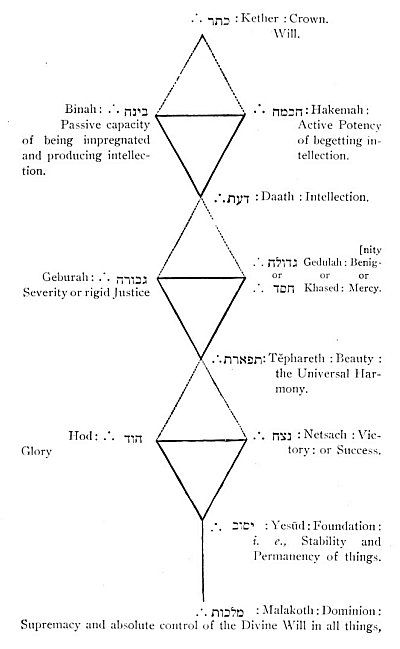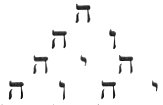These being the conflicting elements in the breast of man; the old inheritance or original dowry of truth, imparted to him by God in the primitive revelation; and error, or the foundation for error, in his degraded sense and spirit now turned from God to nature, false faiths easily sprung up and grew rank and luxuriant, when the Divine Truth was no longer guarded with jealous care, nor preserved in its pristine purity. This soon happened among most Eastern nations, and especially the Indians, the Chaldæans, the Arabians, the Persians, and the Egyptians; with whom imagination, and a very deep but still sensual feeling for nature, were very predominant. The Northern firmament, visible to their eyes, possesses by far the largest and most brilliant constellations; and they were more alive to the impressions made by such objects, than are the men of the present day.
With the Chinese, a patriarchal, simple, and secluded people,
p. 601
idolatry long made but little progress. They invented writing within three or four generations after the flood; and they long preserved the memory of much of the primitive revelation; less overlaid with fiction than those fragments which other nations have remembered. They were among those who stood nearest to the source of sacred tradition; and many passages in their old writings contain remarkable vestiges of eternal truth, and of the WORD of primitive revelation, the heritage of old thought, which attest to us their original eminence.
But among the other early nations, a wild enthusiasm and a sensual idolatry of nature soon superseded the simple worship of the Almighty God, and set aside or disfigured the pure belief in the Eternal Uncreated Spirit. The great powers and elements of nature, and the vital principle of production and procreation through all generations; then the celestial spirits or heavenly Host, the luminous armies of the Stars, and the great Sun, and mysterious, ever-changing Moon (all of which the whole ancient world regarded not as mere globes of light or bodies of fire, but as animated living substances, potent over man’s fate and destinies); next the genii and tutelar spirits, and even the souls of the dead, received divine worship. The animals, representing the starry constellations, first reverenced as symbols merely, came to be worshipped as gods; the heavens, earth, and the operations of nature were personified; and fictitious personages invented to account for the introduction of science and arts, and the fragments of the old religious truths; and the good and bad principles personified, became also objects of worship; while, through all, still shone the silver threads .of the old primitive revelation.
Increasing familiarity with early oriental records seems more and more to confirm the probability that they all originally emanated from one source. The eastern and southern slopes of the Paropismus, or Hindukusch, appear to have been inhabited by kindred Iranian races, similar in habits, language, and religion. The earliest Indian and Persian Deities are for the most part symbols of celestial light, their agency being regarded as an eternal warfare with the powers of Winter, storm, and darkness. The religion of both was originally a worship of outward nature, especially the manifestations of fire and light; the coincidences being too marked to be merely accidental. Deva, God, is derived from the root div, to shine. Indra, like Ormuzd or Ahura-Mazda,
p. 602
is the bright firmament; Sura or Surya, the Heavenly, a name of the Sun, recurs in the Zend word Huare, the Sun, whence Khur and Khorshid or Corasch. Uschas and Mitra are Medic as well as Zend Deities and the Amschaspands or “immortal Holy Ones” of the Zend-Avesta may be compared with the seven Rishis or Vedic Star-God, of the constellation of the Bear. Zoroastrianism, like Buddhism, was an innovation in regard to an older religion; and between the Parsee and Brahmin may be found traces of disruption as well as of coincidence. The original Nature-worship, in which were combined the conceptions both of a Universal Presence and perpetuity of action, took different directions of development, according to the difference between the Indian and Persian mind.
The early shepherds of the Punjaub, then called the country of the Seven Rivers, to whose intuitional or inspired wisdom (Veda) we owe what are perhaps the most ancient religious effusions extant in any language, apostrophized as living beings the physical objects of their worship. First in this order of Deities stands Indra, the God of the “blue” or “glittering” firmament, called Devaspiti, Father of the Devas or Elemental Powers, who measured out the circle of the sky, and made fast the foundations of the Earth; the ideal domain of Varouna, “the All-encompasser,” is almost equally extensive, including air, water, night, the expanse between Heaven and Earth; Agni, who lives on the fire of the sacrifice, on the domestic hearth, and in the lightnings of the sky, is the great Mediator between God and Man; Uschas, or the Dawn, leads forth the Gods in the morning to make their daily repast in the intoxicating Soma of Nature’s offertory, of which the Priest could only compound from simples a symbolical imitation. Then came the various Sun-Gods, Adityas or Solar Attributes, Surya the Heavenly, Savitri the Progenitor, Pashan the Nourisher, Bagha the Felicitous, and Mitra the Friend.

Moe is the founder of GnosticWarrior.com. He is a father, husband, author, martial arts black belt, and an expert in Gnosticism, the occult, and esotericism.





